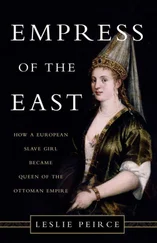For years, Sister Conrad had instructed the daughters of prominent families in the creed of the church. The first part of Sister Conrad’s classes were too boring to remember; first they stood and prayed in Latin to prove they’d memorized the words, then the old nun talked about goodness and sainthood and heaven. But before long Sister Conrad would drift off the shining virtues to the serious topics, which reddened her big Irish face. Hattie was twelve years old the first time Sister Conrad talked about the devil and the fires in hell, and she was spellbound by the old nun’s stories.
Sister Conrad looked each one of them in the eyes as she told stories about the selfish, lying little girls whose behavior was so wicked it caught the attention of the devil himself. Inflamed by their sins, the devil came and hid in their bedrooms — in the closet or under the bed — where he waited to ambush the bad girls. If the sinful girl did not die immediately of fright, then the devil flung her high in the air and let her crash to the floor, where she broke her bones. When Hattie told the devil stories to her father, he appeared concerned and asked if she wanted to stop catechism classes. She quickly said no because she enjoyed her time with girls her own age to gossip and giggle over boys.
Hattie trusted the loving, forgiving God her father described — the God who brought only good to his children and no harm. No devil could harm Hattie — she was confident God loved her too much to allow evil to touch her, and she was curious about the hidden dangers of the world polite people seldom discussed. Her mother’s friends whispered about young women who were “ruined,” but aware Hattie was nearby, they never disclosed the lurid details.
Sister Conrad dropped hints and made innuendos about “bad girls,” who must confess sins of the flesh if they lingered in their warm baths too long. Hattie had no idea what the nun was talking about until she asked the other girls and they told her. Shocked but not surprised, Hattie went home and straight to the library for the set of medical reference books. The chapters on reproduction and childbirth, complete with diagrams and color plates, left Hattie a bit queasy; but she felt sick after her mother described her loss of blood and hours of suffering to bring Hattie into the world! Poor dear! She wasn’t able to have more children.
From time to time a Jesuit priest came to lecture them on church history. He was a pale, heavy man who did not look at them but at the wall at the back of the room. Even when a girl raised her hand with a question, the priest stared at a point above her head. The other girls became restless and bored whenever the priest lectured about the dangers of the loss of their immortal souls, but Hattie secretly was thrilled at the drama of the old struggle between God and the devil played out in endless new situations.
The priest began his instruction on the early history of the church with the third day after Christ’s crucifixion. Naturally, Jesus’ followers were grief-stricken and confused — Hattie felt tears in her eyes as the priest related the event: Mary Magdalene was the first to see the risen Jesus, but Peter refused to believe her. Why would Jesus appear first to a woman like Mary Magdalene? Hattie felt indignant at the injustice; she raised her hand and the Jesuit nodded at her. The other disciples did not like Mary Magdalene, Hattie said; they were jealous of her because of Jesus’ regard for her. Boldly Hattie went on: perhaps the reason Jesus appeared to her first was to teach the other disciples a lesson in humility. The Jesuit remained expressionless. A divine mystery, he said; only God knew the answers.
Hattie was fascinated by the early years of the church; heresies sprang up almost as soon as Jesus was crucified. Week after week, the pale Jesuit took them over the great heresies: Gnostic, Arian, Nestorian, Pelagian, Waldensian, Albigensian, Lutheran, Calvinist, and Anglican. The girls made up a singsong chant of the names to memorize them for the quiz. The history of church heresy was far more interesting than the lives of the saints, though the stories of martyrdom by fire and steel were comparable. The other young women in the religion class talked about nothing but young men and marriage; though Hattie was interested, still she preferred books.
At home, Hattie read all the books of mythology she could find. When she finished with Greek, Roman, and Norse mythology, she began to read about the Egyptians. Her interest in archaeology came from her passion for hidden tombs and mummies. She loved to read Shakespeare’s plays — weepy Richard II and malevolent Richard III were favorites; suave, brilliant Lucifer of Milton’s Paradise Lost captivated her.
Her mother insisted she take riding lessons for the benefits of fresh air and sunshine; she wanted Hattie to develop normal interests and hobbies to take her away from her books long enough to find a suitable husband.
She galloped her pony in the dunes above the bay; she loved the rush of the wind in her face and the sensation of flying above the powerful muscles of the horse. Her father sent along a groom at a discreet distance in case of a fall; otherwise Hattie rode alone. A ride along the beach cleared the mind and allowed completely new ideas to spring up. She loved to imagine she was Joan of Arc riding to battle or a knight of the Crusades.
By the time she completed her studies under her father’s direction and departed for college, Hattie had exhausted their own library of books about early Christianity. They saw two white swans and a black swan from the train window on their way to Poughkeepsie to settle Hattie at Vassar.
Hattie completed her course work with honors in three years; Mr. Abbott spoke with pride about Hattie’s interest in the early church and her desire to continue with graduate studies. A Harvard graduate himself, Mr. Abbott arranged with the Divinity School to allow Hattie to attend lectures as a nondegree student until she proved she was capable of distinguished graduate work.
Mrs. Abbott did not share her husband’s enthusiasm for Hattie’s continued education; she feared Hattie’s reputation might be compromised. How many respectable gentlemen wanted scholars of heresy for wives? Why must she go to Harvard when Columbia was so much closer? But Mrs. Abbott knew when she was outnumbered and graciously accompanied Hattie to the comfortable town house rented near Harvard Square. Mr. Abbott intended to stay home in Oyster Bay with his wind power experiments, but loneliness quickly sent him to them, accompanied by the cook and coachman.
Hattie’s father contacted his old friend Dr. Rhinehart in Cambridge and arranged for Hattie to use his private library from time to time. A scholar of ancient Coptic manuscripts, Dr. Rhinehart’s library of texts and treatises of early church history was remarkable, an equal of Harvard’s collection; Hattie was delighted.
Months later the doctor blamed the overstimulation of the lectures in the presence of young gentlemen for Hattie’s illness. The doctor confided to Mrs. Abbott that he treated many more nervous disorders in young women since the advent of Margaret Fuller, Mrs. Eddy, and the like. But Hattie thought her illness seemed quite natural in view of the incidents that preceded it.
Dr. Rhinehart’s library surpassed Hattie’s expectations. The sight of so many ancient scrolls in glass cases, and folios of early church history shelved from the ceiling to the floor, took away Hattie’s breath. She was silent as she moved around the shelves to savor the scent of leather bindings and glue. The beauty of the bindings caught her attention; the arrangement of the books on the shelves was precise but not by author or title or time period. Here and there volumes bound in red leather and saffron vellum were clustered together amid volumes of fawn, chocolate, and hunter green leather; bindings of black leather formed borders, so the effect was of a lovely strange garden.
Читать дальше












